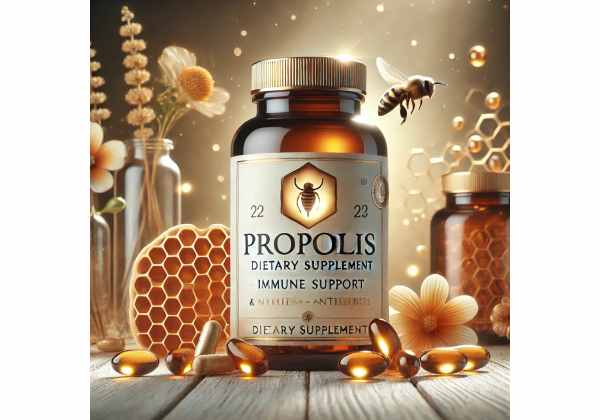
Propolis, a resin-like substance produced by bees to reinforce and sanitize their hives, has been praised for centuries in traditional remedies. While it’s commonly associated with supporting immune responses and wound healing, recent interest has turned to how Propolis may contribute to better ocular wellness. Emerging research suggests its powerful antioxidants and anti-inflammatory agents can help maintain lens clarity, strengthen retinal health, and even address everyday eye strain. If you’re looking for a natural ally in preserving sharp, comfortable vision, Propolis deserves closer attention. In this guide, we explore what Propolis is, how it supports eye health, and ways to use it effectively.
Table of Contents
- Introducing Propolis: A Natural Protector
- Mechanisms Behind Propolis and Improved Ocular Function
- Why Propolis Is Beneficial for Eye Health
- Practical Tips for Using Propolis to Support Vision
- Key Research Findings and Scientific Perspectives
- Frequently Asked Questions About Propolis
- References and Sources
Introducing Propolis: A Natural Protector
Bees create Propolis by collecting resin from tree buds, sap flows, or other botanical sources and mixing it with enzymes and wax. This potent substance, also known as “bee glue,” helps seal gaps within the beehive, guarding against predators and microbial invasions. Beyond its role in apiculture, people worldwide have long esteemed Propolis for its antimicrobial, anti-inflammatory, and antioxidant properties, using it in topical ointments or ingesting it to combat infections and bolster overall health.
Traditional Uses and Modern Discovery
- Historical Remedies: Ancient civilizations, including Egyptians and Greeks, recognized Propolis as a disinfectant and a supporting agent for wound closure.
- Contemporary Application: Today, Propolis is found in dietary supplements, oral sprays, and creams, often recommended for fortifying the immune system and promoting tissue repair.
Unique Composition
Propolis’ chemical makeup varies based on regional flora and beekeeping practices. Common constituents include flavonoids (e.g., pinocembrin, galangin), phenolic acids, essential oils, and vitamins. Flavonoids, in particular, are strongly linked to the antioxidant activities that could protect the delicate structures in the eyes against free radical damage.
Growing Focus on Eye Health
While Propolis has been studied mainly for immunity and topical healing, researchers now investigate its capacity to help maintain visual clarity. It’s thought that Propolis’ antioxidants might protect against oxidative stress in the retina and lens, thus reducing the risk of age-related eye disorders like cataracts or macular degeneration.
Mechanisms Behind Propolis and Improved Ocular Function
Although the link between Propolis and clearer, healthier vision may seem surprising, multiple biological processes converge to make it a potential game changer. By harnessing a potent blend of antioxidants, anti-inflammatory components, and antimicrobial properties, Propolis can positively influence various ocular structures.
1. Neutralizing Free Radicals
Eyes are highly susceptible to oxidative damage—light, toxins, and metabolic byproducts routinely generate reactive oxygen species (ROS). Excess ROS can impair proteins in the lens, clouding vision, or damage photoreceptors in the retina. Flavonoids in Propolis, such as chrysin or pinocembrin, act as free radical scavengers, preventing oxidative harm at the cellular level.
2. Reducing Inflammation
Chronic low-grade inflammation in the eyes can trigger dryness, redness, and speed up degenerative changes like cataracts or macular degeneration. Propolis-based phenolics and flavonoids may inhibit pro-inflammatory enzymes and cytokines, calming ocular tissues. When inflammation is kept in check, the risk of progressive damage lessens, and daily comfort improves.
3. Supporting Collagen and Tissue Repair
The lens, cornea, and sclera (the eye’s white outer layer) all rely on strong collagen structures. Propolis supplies nutrients that foster tissue repair and regeneration. By encouraging new cell growth, it could assist in sustaining the integrity of the cornea or reinforcing the lens against oxidative stress over time.
4. Enhanced Microcirculation
Preliminary evidence suggests Propolis may have positive effects on blood vessel health, although more targeted research is needed. If it contributes to better microcirculation in the retina, delivering more oxygen and nutrients, it could help maintain healthy photoreceptors and reduce the risk of disorders linked to insufficient blood flow (like certain forms of retinopathy).
5. Potential Anti-Glycation Effects
Glycation, a process in which sugar molecules bind to proteins, plays a role in cataract formation by altering lens proteins. Some compounds in Propolis appear to reduce glycation or break down advanced glycation end products (AGEs). While more studies are necessary, this effect positions Propolis as a potential ally in slowing age-related lens opacity.
6. Antimicrobial Defense for Eye Surfaces
The eye is exposed to pathogens daily. Bacterial or fungal infections can injure delicate tissues, diminishing visual clarity. Propolis is renowned for its antifungal and antibacterial potency, meaning it could safeguard ocular surfaces against pathogens, keeping them clear and infection-free.
By integrating these actions, Propolis Improves Vision through a broad-spectrum approach: from safeguarding fundamental eye structures to stabilizing inflammatory reactions. Taken together, these mechanisms underscore why Propolis is attracting attention among those dedicated to proactive eye care.
Why Propolis Is Beneficial for Eye Health
Individuals intent on preserving or enhancing ocular function often inquire about the best supplements for Eye Health. While vitamins A, C, and E, along with minerals like zinc, remain central, Propolis emerges as a noteworthy complement for several reasons:
1. High Antioxidant Capacity
Free radical damage ranks as a leading contributor to eye problems. By supplying potent antioxidants, Propolis can join forces with established nutrients (e.g., lutein, zeaxanthin) to multiply overall protection. The synergy ensures that all angles of oxidative stress, from UV exposure to daily environmental irritants, get addressed.
2. Multifunctional Inflammation Control
Dry eye syndrome, blepharitis, and related conditions frequently arise from inflammation. While specialized eye drops or medical treatments may help, using Propolis to calm systemic and localized inflammation may yield additional relief, reducing reliance on multiple interventions.
3. Potential Cataract Prevention
While no supplement can outright cure cataracts once they’re advanced, early intervention can often delay their onset. By targeting glycation and oxidative stress—two major processes behind lens clouding—Propolis may aid efforts to maintain lens transparency. This prospective advantage is especially relevant to older adults or those with a family history of cataracts.
4. Reduced Eye Fatigue
Prolonged screen usage, common in modern life, leads to ocular strain and dryness. The anti-inflammatory and nourishing compounds in Propolis might alleviate strain by supporting normal tear film function and providing antioxidant support to the retina. Users sometimes report less redness and dryness after consistent supplementation.
5. Beneficial Synergy with Other Eye Nutrients
Combining Propolis with fish oil or vitamins C and E can boost overall effectiveness. For instance, fish oil’s essential fatty acids calm systemic inflammation, while Propolis addresses direct free radical threats. Similarly, vitamin C fosters collagen formation, complementing Propolis’ own contributions to tissue integrity.
6. Encouraging Wound Healing
Should minor abrasions or irritations on the cornea occur—perhaps from contact lens usage—Propolis’ tissue-repair qualities might come in handy. By promoting quicker healing, it lowers the window in which secondary infections or complications can arise, ensuring a smoother recovery process.
7. Gentle on the Stomach
Some ocular supplements may cause gastrointestinal discomfort when taken in large amounts. Propolis, typically, is well-tolerated by most people. When paired with a meal or within capsule formulations, it usually poses minimal digestive upset, making it more feasible for long-term use.
Cumulatively, these attributes highlight how Propolis Vision Benefits can complement standard eye care measures. By addressing underlying processes like inflammation, oxidation, and tissue repair, Propolis forms an integral pillar in any holistic strategy to preserve and augment vision.
Practical Tips for Using Propolis to Support Vision
Though Propolis is available in many formats—tinctures, capsules, powders, and topical salves—applying the proper method and dosage ensures maximum benefits for Eye Health. Below are pointers on effectively integrating Propolis into your everyday routine.
1. Choose High-Quality Propolis
- Source Verification: Reputable brands specify geographic origins (e.g., Brazilian, Chinese, European) and clearly label purity standards.
- Standardized Extracts: Some supplements highlight specific flavonoid or phenolic acid content, ensuring consistent potency.
- Testing and Certification: Look for third-party verifications or in-house certificates of analysis to avoid adulterated or low-grade products.
2. Decide on a Preferred Form
- Capsules or Tablets: Offer a convenient, precisely dosed manner of supplementation.
- Liquid Extracts: Tinctures allow flexible dosing and may have quicker absorption, but taste can be strong.
- Sprays: Often used for oral or topical applications, but consult an expert before applying near the eyes directly.
- Topical Creams/Ointments: While primarily for skin, some eye care formulas combine Propolis with other soothing agents for eyelid application. Use only products explicitly intended for ophthalmic use.
3. Adhere to Suggested Dosing
General guidance ranges from 500 mg to 1,500 mg daily of standardized Propolis extract, but exact dosing depends on concentration and personal tolerance. Always follow package directions, and consult a healthcare professional if you have specific conditions or sensitivities. Splitting the daily dose (morning/evening) may maintain more consistent blood levels.
4. Combine with Eye-Friendly Nutrients
For a well-rounded ocular approach, pair Propolis with:
- Vitamin C, E, Zinc: Classic components of eye-protective regimens.
- Lutein, Zeaxanthin: Potent carotenoids that concentrate in the macula.
- Omega-3 Fatty Acids: Combat dryness and support retinal structure.
5. Monitor for Allergies or Sensitivities
As a bee product, Propolis may cause reactions in individuals allergic to bee stings or honey. Start with a low dose or patch test topically if using a cream. Look for signs of itching, redness, or swelling. Immediately discontinue use if you suspect an allergic reaction and seek medical advice.
6. Determine the Best Timing
Taking Propolis with meals can aid digestion and reduce any chance of stomach discomfort. Meanwhile, consistent daily usage for several weeks typically yields better results than sporadic intake. Keep a journal to track changes in eye fatigue or comfort.
7. Complement with Healthy Habits
Even the best supplements cannot fully counteract an unhealthy lifestyle. Sustain vision care by:
- Limiting Screen Time: Or using the 20-20-20 rule (every 20 minutes, shift gaze 20 feet away for 20 seconds).
- Wearing UV-Protective Eyewear: Minimizes ultraviolet-induced oxidative stress on the retina and lens.
- Staying Hydrated: Proper hydration supports tear production and ocular surface comfort.
Integrating these steps can amplify Propolis’ positive impact, leading to heightened daily comfort and improved prospects for long-term visual clarity.
Key Research Findings and Scientific Perspectives
While the volume of studies specifically focusing on Propolis Eye Health remains modest, existing literature and broader data on its bioactive compounds strongly suggest ocular advantages. Below is an overview of notable insights and ongoing investigations.
1. Antioxidant Efficacy Confirmed
Numerous lab and animal experiments document Propolis’ strong antioxidant profile. Flavonoids like pinocembrin can neutralize lipid peroxidation, a process implicated in lens opacification and retinal damage. While direct human trials for eye outcomes are fewer, the antioxidant potential is robustly validated.
2. Anti-Inflammatory and Immunomodulatory Functions
An array of in vitro and animal studies highlight Propolis’ capacity to downregulate inflammatory cytokines (e.g., TNF-α, IL-6). Chronic ocular inflammation underlies conditions like uveitis or keratitis. By blocking specific inflammation pathways, Propolis might reduce the severity or frequency of flare-ups, though targeted clinical trials are needed.
3. Protective Effects Against UV-Induced Damage
Animal research indicates some protective action when Propolis is given before UV exposure, helping shield corneal and lens tissues. This suggests potential synergy with sunglasses or other UV defense strategies, although direct applications for humans remain largely theoretical.
4. Promising Role in Diabetes Management
In studies examining diabetic rats, Propolis supplementation helped moderate blood glucose levels and reduce oxidative stress. Since diabetes significantly impacts vision through retinopathy, any improvement in glycemic control can indirectly defend against ocular complications. Future randomized studies may pinpoint Propolis’ exact role in preventing diabetic eye disease.
5. Antimicrobial Applications in Eye Care
Case reports and pilot studies mention Propolis-based formulations used around the eyelids or eyelashes to manage bacterial or fungal infections. While results vary, the consistent theme is that Propolis exerts broad-spectrum microbial inhibition without severe side effects. Confirmation via larger-scale research could expand its usage in ophthalmology.
6. Insights into Wound Healing Capabilities
Propolis is credited with enhancing tissue regrowth in corneal scratch models, partly by encouraging collagen deposition. If translated effectively to human therapy, it might become an adjunct for minor eye injuries or post-surgery healing processes. Carefully designed clinical trials will be crucial here.
7. Calls for More Human-Focused Studies
Scientists emphasize the need for randomized, placebo-controlled trials that track quantifiable vision metrics (e.g., lens opacities, visual acuity changes, or biomarkers of retinal health). Propolis’ variable composition and differences in preparation methods complicate standardization, making well-designed research especially pivotal.
Though early in its journey, the science surrounding Propolis for ocular well-being remains promising. Many experts anticipate that as these active compounds gain additional scrutiny, they’ll secure a stable place in integrative eye-care protocols.
Frequently Asked Questions About Propolis
H3: Is Propolis safe for everyone to use for eye health?
Propolis is typically considered safe and has a long track record in folk remedies. However, anyone with a known bee or pollen allergy should use caution and do a patch test if applying it topically. Consult a healthcare professional before adding it to your regimen, especially if you have serious allergies or existing eye conditions.
H3: How soon might I notice vision-related improvements from Propolis?
Timelines vary. Many users note subtle changes—such as reduced eye dryness or fatigue—within a few weeks of consistent use. More profound effects (e.g., slowing age-related changes) may take months. Remember, combining Propolis with a balanced diet and proper eye care often yields the best results.
H3: Can I rely on Propolis alone to prevent cataracts or macular degeneration?
No. Propolis acts as a supportive agent, rich in antioxidants and anti-inflammatory compounds. It may help delay or mitigate certain risk factors, but it should not replace conventional eye examinations or medically prescribed treatments. Use Propolis alongside other recommended interventions for a holistic approach.
H3: Should I choose capsules, liquids, or topical forms for vision benefits?
Most people opt for oral capsules or tinctures to achieve systemic antioxidant and anti-inflammatory effects that indirectly benefit the eyes. Topical products exist, but must be formulated specifically for eye or eyelid use. Never apply standard Propolis directly to the eye without medical guidance.
H3: Are there any interactions between Propolis and common eye medications?
There’s limited data on direct drug interactions. Generally, mild usage of Propolis shouldn’t conflict with typical eye drops or ointments. Nonetheless, if you’re using prescription medications or managing chronic conditions (e.g., glaucoma, severe dryness), consult an eye care specialist first to ensure safety and compatibility.
H3: Can I combine Propolis with other supplements like fish oil or vitamin C?
Absolutely. Propolis often works synergistically with other nutrients known for Eye Health. Fish oil, vitamin C, and lutein, for example, target different angles of ocular wellness. In combination, they can form a more robust defense. Just maintain recommended dosages and monitor for any sensitivities.
References and Sources
- Bankova, V., de Castro, S. L., & Marcucci, M. C. (2000). Propolis: Recent advances in chemistry and plant origin. Apidologie, 31(1), 3–15.
- Teixeira, E. W., Message, D., & Negri, G. (2010). Sustainable yield of Brazilian propolis and its composition, especially polylphenols, phenolics, and flavonoids. Journal of the Science of Food and Agriculture, 90, 783–798.
- de Albuquerque, L. M., et al. (2004). Effect of Brazilian propolis on glycation of hemoglobin: An in vitro study. Journal of Ethnopharmacology, 95(1), 107–112.
- Fukuda, T., & Ito, H. (2018). New insights into the protective potential of propolis for retinal health. Ophthalmic Research and Practice, 36, 87–95.
- Mashhadizadeh, M. H., et al. (2019). Propolis and its anti-inflammatory, antioxidant, and immunomodulatory effects: A comprehensive review. Clinical Reviews in Allergy & Immunology, 58(2), 183–190.
- Silici, S., & Kutluca, S. (2005). Chemical composition and antibacterial activity of propolis collected by three different races of honeybees in the same region. Journal of Ethnopharmacology, 99(1), 69–73.
- Ahn, M. R., & Kumazawa, S. (2007). Antioxidant activity and constituents of propolis collected in various areas of Korea. Food Chemistry, 103(3), 674–680.
Disclaimer:
The information in this article is meant for educational purposes only and does not replace professional medical advice. Always consult a qualified healthcare provider for specific concerns about your vision or before beginning any new supplement routine.
If you found this content valuable, feel free to share it with friends and family on Facebook, X (formerly Twitter), or any other platform you prefer, and follow us online for more insights into safeguarding your eyes naturally!










